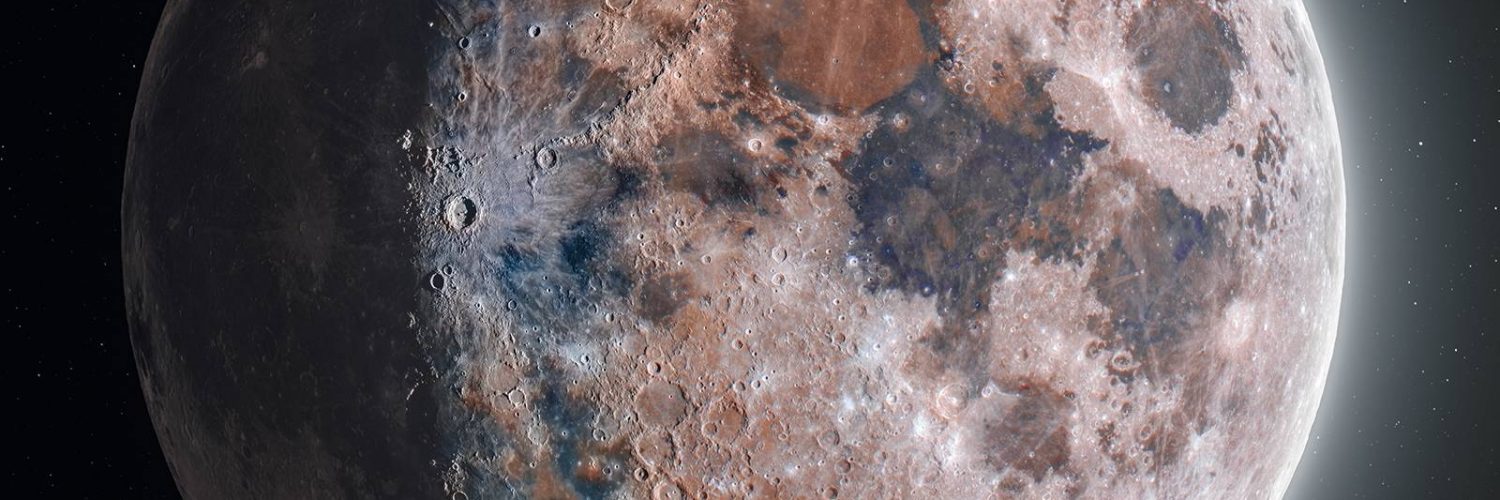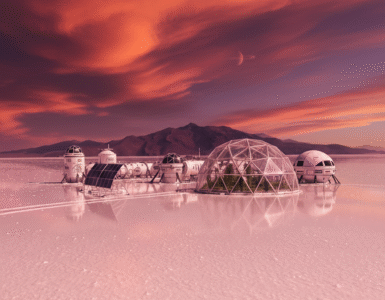By A’liya Spinner
Tribulations at Tranquility Base
For once, the lunar base at the edge of the Sea of Tranquility was quiet. Fatima sat cross-legged on her cot, a tablet in her lap. Her “room” was more of a closet, really, with nothing more than a pull-down bed and space-conscious drawers that contained all of her few personal possessions. The walls were covered in drawings and stickers, some photos of the moon’s surface and of her family back home. Every inch of the cramped space had been personalized to the best of her ability; the rest of the lunar base was sterile and pristine, cleaned and polished and inspected and scrubbed free of any trace of use. She valued the chance to express herself in her private space, at least a little.
“It’s your move,” Georgi— the station’s resident AI companion and occasional therapist— chimed in.
“I know, I know,” Fatima said, waving her hand at the air before swiping at the screen of her tablet. She and Georgi were playing a game of chess as they occasionally chatted, and she, as usual, was losing. The computer responded to her hurried move almost immediately, needing no time to dither like she did.
Her contemplation was interrupted by a knock on the door. Before she was able to respond, the door slid open and her colleague strode in, dressed in his mission uniform. Fatima sighed and put the tablet down.
“We talked about this, Osvald,” she grumbled. “You can’t just walk in on people’s space without permission.”
“I knocked,” he defended. Fatima rolled her eyes and stood, adjusting her recreation clothes. Osvald pestered everybody on the base, but it came from a place of good intentions. He was their resident nutrition expert and chef, so if he was coming to her on off-hours, he probably needed some sort of help. She decided that she could scold him later, at the communal meeting where the fifteen members of the crew gathered and discussed any interpersonal or mechanical errors they had encountered.
“What’s the matter?” Fatima asked, grabbing a toolkit from an alcove in the wall. She was the senior of the two mechanics aboard the station, a vital member of the team, even if she, herself, wasn’t responsible for conducting the advanced research that occurred here. Osvald stepped back to allow her access out into the corridor and began to talk.
“Well, I was cooking in the mess hall—” mess hall was a generous term for the small habitat pod containing both the kitchen and the dining tables, “—and I noticed there was an issue with some of the pipes. Usually I’d ask mission control for help, but with the time delay… and you know, it’s probably nothing serious anyways. So I was hoping you could just take a look, and—”
There was shouting up ahead, cutting Osvald off and echoing in the slender hallways of the base. Fatima immediately broke into a sprint, the chef following close behind her. A moment later, a pair of disheveled researchers rounded the corner up ahead at a jog, babbling to themselves and waving frantically at the mechanic.
“One of the oxygen lines burst!” The taller of the two— a Nigerian astrophysicist named Sani— panted, out of breath from running through the habitat’s halls.
“In the sample processing lab,” her companion, Dr. Flandre, added. “We sealed off that pod and the ventilation systems, and no one was hurt. But I don’t know how we’re going to get in there and fix it. There’s no airlock set up over there.”
The rest of the crew was beginning to appear, rushing in from wherever they’d been. Tranquility Base was small, and noise carried through the interconnected habitat pods. They looked relieved to see that Sani and Flandre seemed uninjured, but anxious murmurs soon began to pass between them.
“How are we supposed to finish our work without a sample lab?”
“The next resupply from Earth isn’t for another seven months!”
“We’ll need to check the other lines… what if another one breaks?”
Fatima stepped forward, resting a hand on Sani’s shoulder as the astrophysicist trembled with residual nerves. Then, the mechanic turned back to face the small assemblage of lunar explorers. She knew them all well— it was impossible not to make friends with your neighbors when you all lived in the same house, trapped inside by the inhospitable lunar surface.
“We’ll figure this out,” she consoled them. “We’ll send a message to Earth and wait for their reply. In the meantime, Georgi and I can figure out some way to make a makeshift airlock. And we’ll send teams out to check the rest of the ventilation systems. We might be on our own, but we still have each other. It’s going to be okay.”
This was met with nods and murmurs of agreement. They’d been lucky so far, not to face any sudden disasters. But they were also trained to handle them. Fatima lifted her toolkit.
“Let’s get to work.”
Life in Isolation
Today, researchers studying some of the most remote places on Earth— like the deep ocean and the Arctic— spend weeks to months in isolation from the rest of the world, often in hazardous environments and in cramped living conditions. Scientists working for the British Antarctic Survey, along with supportive colleagues including chefs, doctors, carpenters, and boaters, often spend six-month winters at small BAS research stations in groups that rarely get larger than thirty. Though well-supplied with food, film and book libraries, and satellite access that allows social media and email use, many of these intrepid explorers say that the unending darkness and cold of the multi-month Antarctic night quickly becomes an irritant. They reported becoming easily annoyed with the most minute housekeeping duties, and growing restless in the connected pods of the research station, often unable to leave for days or weeks on end due to raging storms. The close quarters with their coworkers also led to “love triangles” and failed relationships, interpersonal conflict, and intergroup tension that was only inevitable in a place with so little room for personal space or secrets. Still, the BAS researchers often return the next winter, and say they find joy and fulfillment in their work.
But not all people handle isolation so well. In 2020, 21-year-old Albert had to be medically evacuated from the Polish Polar Station after experiencing extreme psychotic distress. In the days leading up to his evacuation, he described extreme homesickness, unsatisfaction in his research, and a sense of intellectual decline from lack of stimulation. His personal logs also detailed his mounting frustration with his colleagues and anger at perceived mistreatment with no one to turn to for help. And Albert, while an extreme case worthy of being removed on grounds of medical emergency, is not alone in these feelings. One study on British Antarctic Survey teams found that group isolation had an overall negative mental and emotional effect on those involved, and could even drive formerly healthy individuals to destructive or violent outbursts. Another study found that there was no easy way to determine who would not adapt well to Arctic isolation— while most researchers were reasonably well-adjusted prior to and throughout the mission, all suffered some form of isolation-induced stress, and those that faced larger mental health crises were not united by any sort of background, preexisting conditions, or personality traits. Reacting poorly to isolation seems to be an innately human response, no matter how self-reliant or introverted some individuals claim to be.
Ongoing Research
The study of group and individual psychology during long, isolated missions is nothing new. But with an increased push for longer and human-crewed exploration into space (and possibly even human settlement on Mars), it has become even more important to understand the effects that these missions might have on the people who undertake them.
Given the scope of human psychology and group dynamics, forms of research on this subject vary considerably. As well as studying real, working people in isolation— such as the British Antarctic Survey teams— controlled environments are also being used to study specific scenarios. For example, a group of fifteen volunteers in France recently entered a cave for forty days with no sunlight, no contact with the outside world, and only basic amenities. Brain activity and cognitive function of the volunteers was measured prior to their isolation, to be compared after the course of the experiment. The goal is to study the effects that “losing a sense of time and space” has on a human mind, something space travelers will no doubt experience after spending months in a weightless environment without the traditional day and night cycles of a spinning planet. Of course, astronauts will maintain contact with their families and mission experts back on Earth, unlike the completely isolated volunteers in the cave, which will help to prevent extreme loneliness and emotional distress. But the French study will still provide valuable information on the effects of losing time and space, and possibly what routines and strategies the volunteers discovered during their forty day exile that helped combat feelings of claustrophobia and listlessness.
NASA also conducts experiments aimed specifically at studying the dynamics of potential Martian or Lunar habitats, cut off from the easily-accessed resources of Earth. The largest of which was the first HI-SEAS mission, in which six volunteer researchers lived in an isolated, cramped habitat atop a desolate Hawaiian volcano for eight months. Once a week, the researchers would venture out in bulky suits similar to the sort that might be worn on another planet, and they had limited access to water, electricity, and food, simulating the freeze-dried meals and recycled bathwater that astronauts contend with every day. Since its initial success, HI-SEAS has conducted several follow-up missions— not all of which have gone so smoothly. In one experiment, a crew member had to withdraw due to a chronic medical condition; in order not to compromise the integrity of the isolation, the remaining researchers agreed to act as if their colleague had died and been left on the barren Martian surface to delay decomposition until an Earth burial became possible. The withdrawing (“dead”) individual was able to leave the facility on their own, and was picked up by an evacuation team, preserving the illusion of no-contact. But in mission six, the need for evacuation was much more urgent; a team member was electrocuted during a maintenance excursion and started developing symptoms that her teammates worried might’ve been a heart attack. She was not able to calmly “die” and remove herself from the simulation; emergency services came, and took her away for emergency treatment, compromising the integrity of the mission.
The crew member’s removal from mission six was controversial among her colleagues while they argued about whether or not to end the experiment. Some of them had given up their jobs and flown from around the world to partake in the research, and would be left in an awkward position if forced to end before the projected eight month finish line. But others prioritized the safety of their friend above everything else, leading to arguments and social splintering; eventually the call was made, and the mission was finished. It led to questions of true isolation— what would happen to an injured person on Mars? The crew had basic first aid training, but what they needed was a doctor— which means a highly-trained physician, and their equipment, will have to be included on manned missions to other worlds. That means trade-offs, more planning, and healthcare providers willing to make the 160 million mile mission.
HI-SEAS is temporarily pausing experiments as they grapple with the questions raised by mission six. As calls for Martian colonization increase in popularity, their work and research will become all the more vital, hopefully solving these crises on Earth before we encounter them on Mars.
What We’ve Learned
Despite all the obstacles we’ve encountered, through experimentation and research, we’ve learned a lot about group psychology in isolation, and how to design a habitat, team, and procedure that helps prevent some of these conflicts. For example, researchers at the BAS stations stressed the importance of having private space to escape to after long days in cramped conditions with their colleagues. Physical, private space as being vital to mental health is something we’ve only recently started to appreciate, especially in an era of urban super-centers, roommates, and sociality. Space reserved only for one individual allows us to process strong emotions, express ourselves in decoration and personal hobbies, and mentally recharge. Without it, even the most extroverted person can become overwhelmed, and interpersonal tensions fray. So while interior space may be limited in small space-faring ships or Martian colonies, reserving areas for crew members to call their own might be crucial for maintaining their sense of individuality, and therefore the ability of the group to function effectively together.
Most importantly, though, is fostering a healthy group dynamic before ever entering isolation. Albert, for example, was unfamiliar with the janitorial staff at his research station, and grew to resent them for a perceived laziness, while simultaneously feeling pushed around and infantilized by the team leaders. Much of the conflict in HI-SEAS mission six over whether to end the mission and call for emergency medical support was caused by unfamiliarity and differing priorities among crew members. Both of these situations likely could’ve been avoided— or at least significantly lessened in severity— if team members had spent time together reviewing the mission, talking, and engaging in the real world, prior to entering isolation. The Tuckman’s Stages of Group Development model— a popular baseline for developing and measuring healthy group dynamics— outlines the phases that groups undergo as they engage with tasks and spend time together. The second stage, “Storming”, predicts that any group will encounter some period of argumentation, conflict, and power clashes before they’re able to advance to the productive “Norming” stage, and then eventually to the highly flexible, personally and professionally successful “Performing”. Ideally, groups will have entered a familiar performing stage before isolation ever begins, rather than meeting each other only days before an eight month mission in a high-stress Mars simulation. And they’ll have plenty of time to get to know each other, problem solve, and learn group dynamics; astronaut training at NASA currently takes upward to two years, and Martian missions will probably last longer. If future settlers are trained together— rather than as individuals— it may better foster these strong, lasting relationships necessary to maintaining harmonious groups in isolation.
Technological Aid
Not only has research into group psychology advanced, but the technologies that astronauts will have access to have also developed considerably. Just like 3D printing will enable crews to create tools, medical instruments, and habitat pieces without taking up valuable inventory space until needed, new innovations in entertainment and stimulation will help keep the mental health of researchers in peak condition. Especially, advancements in AI will help mitigate the time delay between messages to Earth, giving real time aid to astronauts as problems arise— one new AI is even being trained in the role of a therapist, able to interpret facial expressions and offer constructive advice to people in need. Though no replacement for regular wellness check-ups with experts back home, artificial intelligence programmed as mental and physical health aids may help catch minor issues before they spiral out of control. Adding friendly or playful personalities to AI companions could also add a level of comfort and expand the social connections of an isolated habitat while saving space, since studies have shown that people tend to enjoy the company of voice-based AI over uncanny robotics, and may turn to them for casual, mindless conversation.
Innovations in entertainment may also alleviate sources of stress. Virtual reality headsets, for example, are being used in senior centers where residents suffer from feelings of isolation and depression, and psychologists are seeing considerable improvements to mental health. VR allows an escape to new environments, games, and scenarios that can provide relief from the monotony of an enclosed habitat or ship. Preventing boredom can be an unexpectedly powerful tool in reducing interpersonal conflict, and the importance of downtime and leisure cannot be overstated. Even astronauts aboard the ISS have plenty of free time to play games, exercise, and relax, to keep the stress of work from taking over every aspect of their lives.
No technology can replace human relationships, but they can augment our social lives, and alleviate homesickness. Artificial intelligence can help problem-solve when Earth is too far away to reply in real time, and virtual reality will supplement the barren expanse of the Moon and Mars. Isolation on this scale has never been attempted before, and it will come with unforeseen challenges, and interpersonal conflict that can never be fully avoided. But thanks to selfless volunteers and experiments here on Earth, we know how to take precautions against common pitfalls, to familiarize astronauts with each other and with their own mental health, and to engineer our habitats in such a way that crew members are able to have both communal and personal space. Humans are a social species, designed by evolution to thrive in groups that share labor and stories, and— perhaps even more importantly than fast engines, innovative waste recycling, and life support systems— we will have to nurture that sociality to survive anywhere we travel to.





